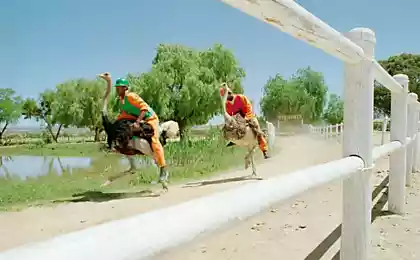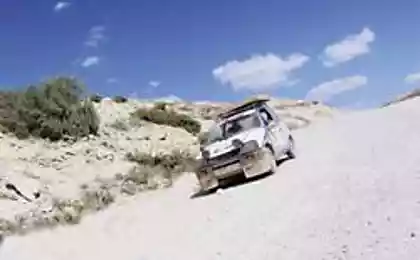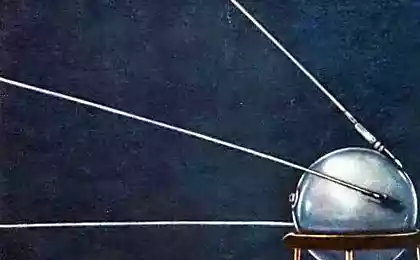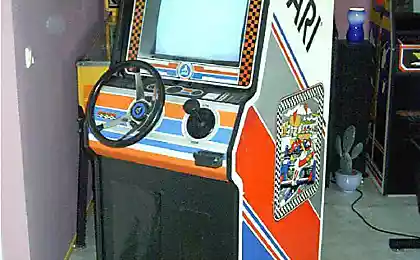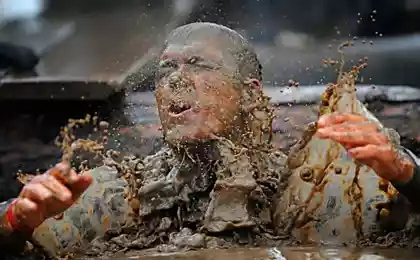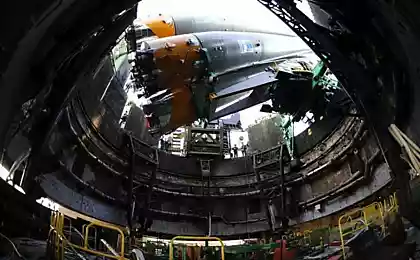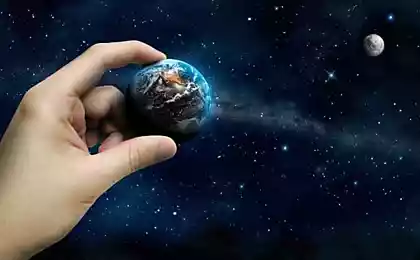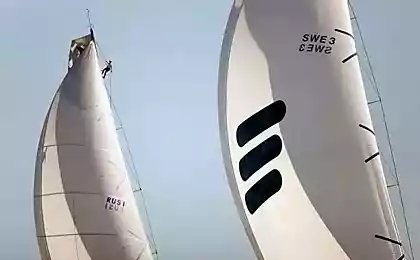1271
At the start of the space race
Comparison of manned spacecraft first generation
It is interesting to see how different people solve the same problem. Everyone has their experience, their initial conditions, but when the purpose and requirements are similar, this task is functionally similar to each other, although they may differ in the specific implementation. In the late 50s and the Soviet Union and the United States have begun to develop manned spacecraft for the first steps into space. Requirements were similar - one man crew, the time spent in space - up to several days. But here's the machine receives a different, and I think it would be interesting to compare them.
via habrahabr.

Introduction
Neither the Soviet Union nor the United States did not know what awaits man in space. Yes, in flight on an airplane can be played weightlessness, but lasting only about 30 seconds. What will happen to a person during prolonged weightlessness? Doctors frightened inability to breathe, drink, see (supposedly eye to lose its shape due to incorrect operation of the eye muscles) to think (frightened madness or loss of consciousness). Knowledge of high-energy particle leads to the idea of radiation damage (and even after flight regularly in newspapers surfaced macabre version of the astronauts who flew radiation sickness). Therefore, the first ships were designed for a short time spent in space. First flight duration measured in minutes, the next - for hours, or turns around the Earth (one round - about 90 minutes).
Launch vehicle
The main factor influencing the design of the ship was carrying capacity of the carrier rocket. And two-stage R-7, and "Atlas" could lead to low-Earth orbit approximately 1300 kg. But for the "Seven" had to work in the lunar launches in 1959 the third stage - the block "E" and raised three-stage rocket carrying capacity up to 4, 5 tons. And the US still could not work out a basic two-step "Atlas" and the first theoretical option "Atlas-Agena" flew only in the early 1960s. The result is an anecdote - Soviet "Vostok" weighed 4, 5 tons, and the weight of "Mercury" was comparable to the mass of the "Sputnik 3" - 1300 kg.
Exterior design elements
Consider first the exterior of a ship:
"East»
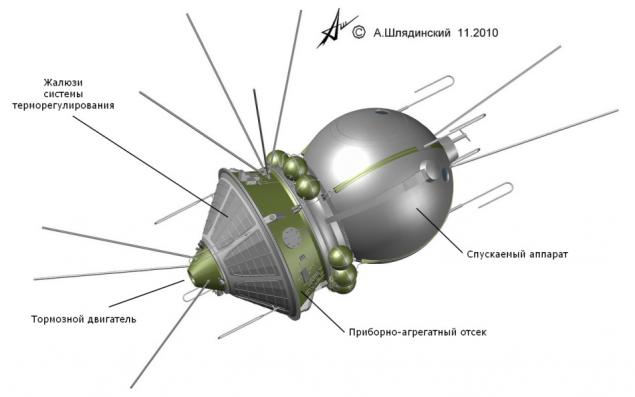
"Mercury»

Hull form
"East" on the ascent was under the blow-off fairing. Therefore, the designers did not care aerodynamic shape of a ship, and you can safely place the antenna, balloons, blinds thermoregulation and other fragile items on the surface of the device. A particular design block "E" to determine the characteristic conical "tail" of the ship.
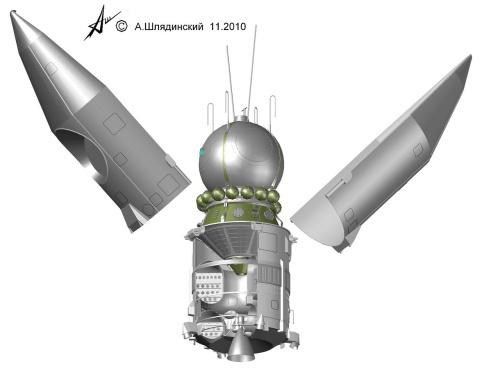
"Mercury" also could not afford to drag into orbit heavy cowl. Therefore, the aerodynamic vehicle has a conical shape, and all sensing elements are retractable type periscope.
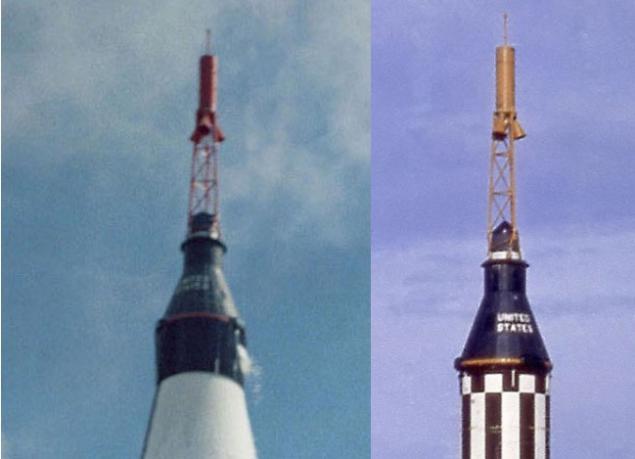
Thermal protection
When you create the "East" constructors based on the decision giving maximum reliability. Therefore, the form lander chosen as a ball. Uneven weight distribution provides the effect of "Vanka-Vstanka" when the lander on their own, without any control, in the right position. A heat shield was applied to the entire surface of the lander. When braking on re-entry impact on the surface of the ball was uneven, so the thermal protection layer has a different thickness.
Left: flow past a sphere at hypersonic speed (wind tunnel), right: unevenly burned lander "Vostok-1».
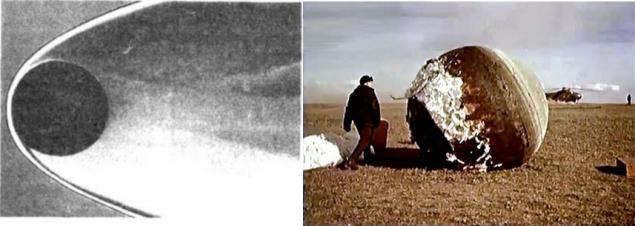
The conical shape of "Mercury" meant that the heat shield is required only at the bottom. On the one hand, it saves weight, on the other hand, incorrect orientation of the ship when entering the atmosphere means a high probability of failure. On the upper part of the ship was a special aerodynamic spoiler that had flipped "Mercury" astern.
Curiously, a heat-shielding material was similar - on the "East" resin impregnated asbestos cloth on "Mercury" - fiberglass and rubber. In both cases tkanepodnobny material filled burned layers and filler evaporates, creating an additional layer of thermal insulation.
Left: the cone of hypervelocity wind tunnel, on the right: Thermal protection "Mercury" after landing.
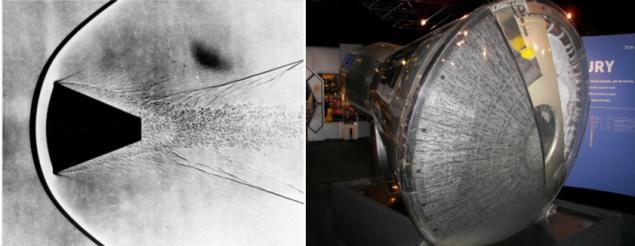
Brake System
Engine brake "East" was laminated. From a security standpoint it was not a very good solution. Yes, the "East" were launched so that within a week slow down naturally to the atmosphere, but, first of all, already in flight, Gagarin's orbit was higher than estimated, that actually "turn off" this backup system, and secondly, the natural inhibition meant landing anywhere from 65 degrees north to 65 degrees south latitude. The reason for this constructive - two LRE does not fit into the vehicle, and then the solid motors have not been disbursed. Reliability TDU increased the maximum simplicity of design. There were times when TDU gave slightly less momentum than you need, but a complete failure was never.
TDU "East»

On the "Mercury" for a thermal shield was the engine block separation and braking. Both engines were established in triplicate for greater reliability. Engines division is turned on immediately after turning off the engine of the launch vehicle to the ship moved away from the launch vehicle at a safe distance. Brake motors are switched to de-orbit. To return from orbit, it was only one actuated brake motor. The engine block is mounted on the steel tape and resets after braking.
TDU "Mercury»
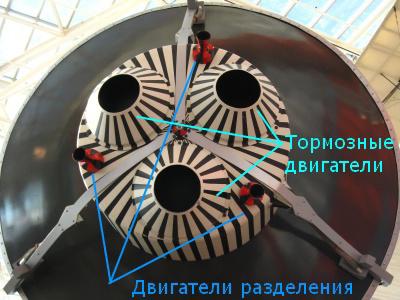
Landing system
On the "East" pilot sat separately from the vehicle. At an altitude of 7 km cosmonaut ejected and sat alone on a parachute. For greater reliability, the parachute system has been dubbed.
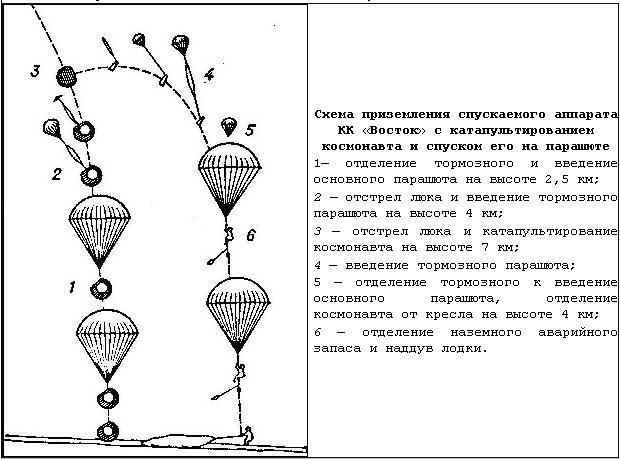
On the "Mercury" used the idea of landing on water. Water softens the blow, and a large fleet of the US does not have trouble finding a capsule in the ocean. To mitigate the impact of water discloses special air-bag shock.
History has shown that planting systems were the most dangerous in the projects. Gagarin almost got into the Volga, Titov landed next to the train, Popovich just is not broken on the rocks. Grissom nearly drowned with the ship, and Carpenter looking for more than an hour and we are counting the dead. The following ships were no bailout pilot or cushion-shock absorber.
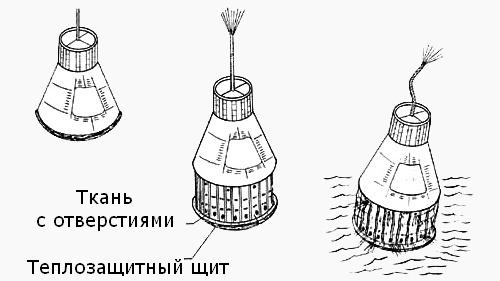
Emergency rescue system
Established ejection system astronaut on the "East" could act as a rescue system in the initial phase. In fairing was a hole for planting astronaut and emergency bailout. Parachute could not make it open in the event of an accident in the first seconds of flight, so right from the launch pad was stretched mesh, which was supposed to cushion the fall.
At high altitude ship was separated from the rocket, using standard tools division.
On the "Mercury" was emergency rescue system, which was supposed to take away from the destructive missiles capsule from the start to the end of the dense layers of the atmosphere.
In the event of an accident at high altitude use standard separation system.
Ejection seats as a rescue system used to "Gemini", as well as a test flight "Space Shuttle". SAS-style "Mercury" was to "Apollo" and still put on "Union».
SAS:
The grid at the bottom of the foreground
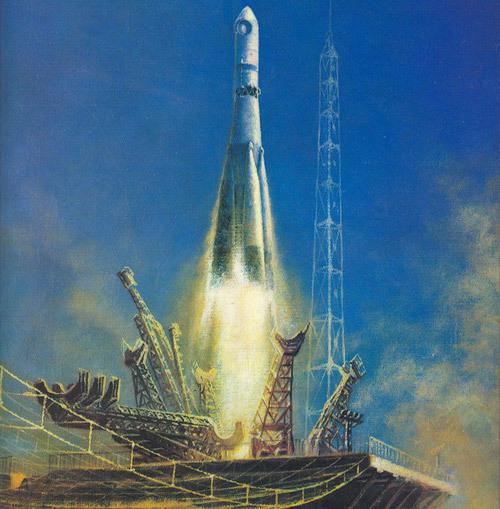
Engines orientation
As a working body for orientation on the ship "Vostok" use compressed nitrogen. The main advantage of the system was easy - the gas is contained in a ball-cylinders and produced with the help of a simple system.
On the ship "Mercury" was used catalytic decomposition of concentrated hydrogen peroxide. In terms of specific impulse is more profitable compressed gas, but reserves the working fluid in the "Mercury" were extremely small. Actively maneuvering, could spend the entire stock of peroxide in less than one turn. But its stock had to be saved for operations orientation when landing ... Astronauts secretly competed among themselves who will spend less peroxide, and involved for a photo Carpenter got into serious trouble - he wastefully spent working body orientation and peroxide over during landing. Fortunately, the height was about 20 km long and catastrophes from happening.
Later peroxide as the working fluid used in the first "union" and then all went to high boiling components UDMH / AT.
Thermoregulatory system
On the "East" used blinds, which is opened by increasing radiating area of the ship, then closed.
On the "Mercury" was a system that uses water evaporation in a vacuum. It was smaller and lighter, but problems with it were more, such as in-flight Cooper she knew only two states - "hot" and "cold».
Internal structural elements
The internal layout of the "Vostok»:

The internal layout of the ship "Mercury»:

Toolbar
Toolbars most clearly show the difference in design approaches. "Vostok" rocket designers do, so it is characterized by a minimum of toolbar controls:
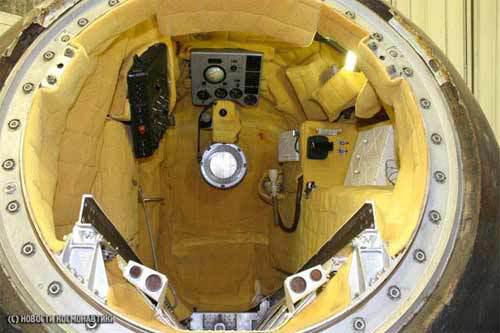
The left panel.

The main panel.
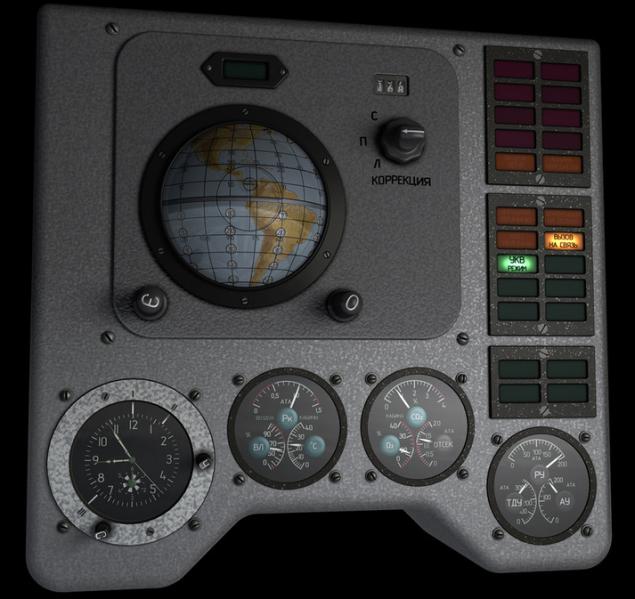
"Mercury" as did former aircraft engineers, and astronauts have made efforts to ensure that the cabin was familiar to them. Therefore, the controls are much more:

Scheme.
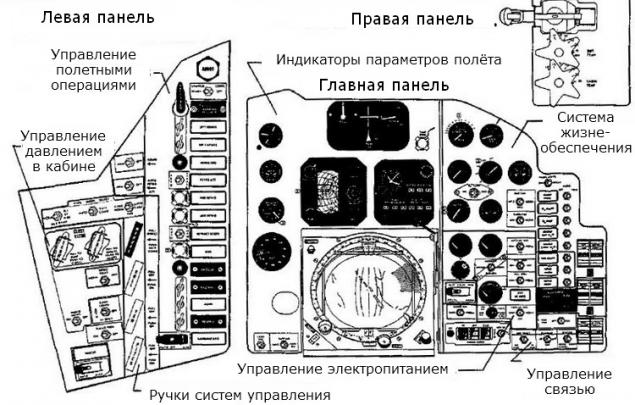
At the same time the similarity of tasks spawned similar devices. And on the "East" and "Mercury" was a globe with a clockwork mechanism, showing the current position of the vehicle and the estimated landing spot. And on the "East" and "Mercury" were indicators of the stages of flight - by "Mercury" is the "Flight Operations Management" in the left pane, in the "East" - indicators "Descent-1", "Descent 2", "Spusk- 3 "and" Prepare to bail "on the front panel. Both ships had a system of manual orientation:
"Gaze" to "East". If the peripheral part of the horizon on all sides, and the Earth at the center moves from the bottom up, the orientation of the braking right.
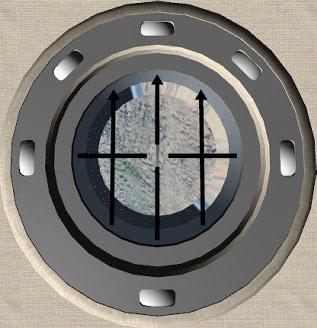
Periscope "Mercury". Marks indicate the correct orientation of the braking.
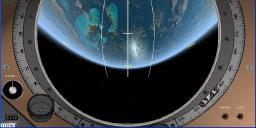
Subsistence
Both ships flight took place in spacesuits. In the "East" was maintained close to the Earth's atmosphere - a pressure of 1 atm, in the air oxygen and nitrogen. On the "Mercury" to save weight the atmosphere was pure oxygen under reduced pressure. This adds inconvenience - the astronaut had about two hours before starting to breathe oxygen in the vehicle, in the breeding had to pit atmosphere of the capsule, and then cover the vent and landing open again to increase the pressure with the weather.
Sanitary system was more advanced at the "East" - flying for several days had the opportunity to meet the large and small needs. On the "Mercury" were only urinals, from large hygienic problems saved a special diet.
Electrical
Both ships using battery power. "East" were povynoslivee on "Mercury" daily flight Cooper completed under fault conditions a good half of the instrument.
Conclusion
Both types of ships were the peak of technology in their countries. Being the first, both types were as good decisions and bad. Ideas of the "Mercury" living in rescue systems and conical capsules and grandchildren "East" still flying - "Photons" and "Bion" use the same spherical landers.
In general, the "East" and "Mercury" were good ships, will make the first steps into space, and avoid fatal accidents.
END
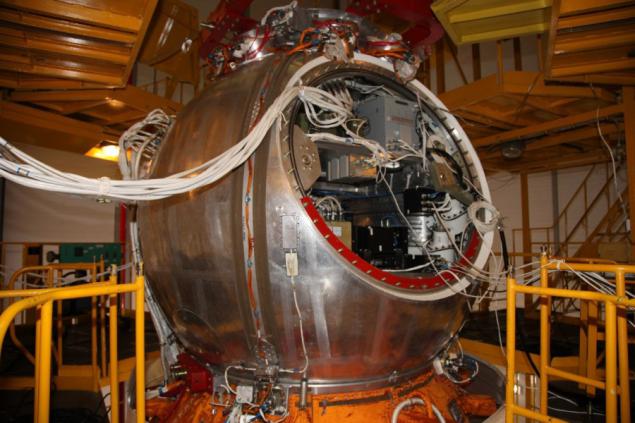
It is interesting to see how different people solve the same problem. Everyone has their experience, their initial conditions, but when the purpose and requirements are similar, this task is functionally similar to each other, although they may differ in the specific implementation. In the late 50s and the Soviet Union and the United States have begun to develop manned spacecraft for the first steps into space. Requirements were similar - one man crew, the time spent in space - up to several days. But here's the machine receives a different, and I think it would be interesting to compare them.
via habrahabr.

Introduction
Neither the Soviet Union nor the United States did not know what awaits man in space. Yes, in flight on an airplane can be played weightlessness, but lasting only about 30 seconds. What will happen to a person during prolonged weightlessness? Doctors frightened inability to breathe, drink, see (supposedly eye to lose its shape due to incorrect operation of the eye muscles) to think (frightened madness or loss of consciousness). Knowledge of high-energy particle leads to the idea of radiation damage (and even after flight regularly in newspapers surfaced macabre version of the astronauts who flew radiation sickness). Therefore, the first ships were designed for a short time spent in space. First flight duration measured in minutes, the next - for hours, or turns around the Earth (one round - about 90 minutes).
Launch vehicle
The main factor influencing the design of the ship was carrying capacity of the carrier rocket. And two-stage R-7, and "Atlas" could lead to low-Earth orbit approximately 1300 kg. But for the "Seven" had to work in the lunar launches in 1959 the third stage - the block "E" and raised three-stage rocket carrying capacity up to 4, 5 tons. And the US still could not work out a basic two-step "Atlas" and the first theoretical option "Atlas-Agena" flew only in the early 1960s. The result is an anecdote - Soviet "Vostok" weighed 4, 5 tons, and the weight of "Mercury" was comparable to the mass of the "Sputnik 3" - 1300 kg.
Exterior design elements
Consider first the exterior of a ship:
"East»

"Mercury»

Hull form
"East" on the ascent was under the blow-off fairing. Therefore, the designers did not care aerodynamic shape of a ship, and you can safely place the antenna, balloons, blinds thermoregulation and other fragile items on the surface of the device. A particular design block "E" to determine the characteristic conical "tail" of the ship.

"Mercury" also could not afford to drag into orbit heavy cowl. Therefore, the aerodynamic vehicle has a conical shape, and all sensing elements are retractable type periscope.

Thermal protection
When you create the "East" constructors based on the decision giving maximum reliability. Therefore, the form lander chosen as a ball. Uneven weight distribution provides the effect of "Vanka-Vstanka" when the lander on their own, without any control, in the right position. A heat shield was applied to the entire surface of the lander. When braking on re-entry impact on the surface of the ball was uneven, so the thermal protection layer has a different thickness.
Left: flow past a sphere at hypersonic speed (wind tunnel), right: unevenly burned lander "Vostok-1».

The conical shape of "Mercury" meant that the heat shield is required only at the bottom. On the one hand, it saves weight, on the other hand, incorrect orientation of the ship when entering the atmosphere means a high probability of failure. On the upper part of the ship was a special aerodynamic spoiler that had flipped "Mercury" astern.
Curiously, a heat-shielding material was similar - on the "East" resin impregnated asbestos cloth on "Mercury" - fiberglass and rubber. In both cases tkanepodnobny material filled burned layers and filler evaporates, creating an additional layer of thermal insulation.
Left: the cone of hypervelocity wind tunnel, on the right: Thermal protection "Mercury" after landing.

Brake System
Engine brake "East" was laminated. From a security standpoint it was not a very good solution. Yes, the "East" were launched so that within a week slow down naturally to the atmosphere, but, first of all, already in flight, Gagarin's orbit was higher than estimated, that actually "turn off" this backup system, and secondly, the natural inhibition meant landing anywhere from 65 degrees north to 65 degrees south latitude. The reason for this constructive - two LRE does not fit into the vehicle, and then the solid motors have not been disbursed. Reliability TDU increased the maximum simplicity of design. There were times when TDU gave slightly less momentum than you need, but a complete failure was never.
TDU "East»

On the "Mercury" for a thermal shield was the engine block separation and braking. Both engines were established in triplicate for greater reliability. Engines division is turned on immediately after turning off the engine of the launch vehicle to the ship moved away from the launch vehicle at a safe distance. Brake motors are switched to de-orbit. To return from orbit, it was only one actuated brake motor. The engine block is mounted on the steel tape and resets after braking.
TDU "Mercury»

Landing system
On the "East" pilot sat separately from the vehicle. At an altitude of 7 km cosmonaut ejected and sat alone on a parachute. For greater reliability, the parachute system has been dubbed.

On the "Mercury" used the idea of landing on water. Water softens the blow, and a large fleet of the US does not have trouble finding a capsule in the ocean. To mitigate the impact of water discloses special air-bag shock.
History has shown that planting systems were the most dangerous in the projects. Gagarin almost got into the Volga, Titov landed next to the train, Popovich just is not broken on the rocks. Grissom nearly drowned with the ship, and Carpenter looking for more than an hour and we are counting the dead. The following ships were no bailout pilot or cushion-shock absorber.

Emergency rescue system
Established ejection system astronaut on the "East" could act as a rescue system in the initial phase. In fairing was a hole for planting astronaut and emergency bailout. Parachute could not make it open in the event of an accident in the first seconds of flight, so right from the launch pad was stretched mesh, which was supposed to cushion the fall.
At high altitude ship was separated from the rocket, using standard tools division.
On the "Mercury" was emergency rescue system, which was supposed to take away from the destructive missiles capsule from the start to the end of the dense layers of the atmosphere.
In the event of an accident at high altitude use standard separation system.
Ejection seats as a rescue system used to "Gemini", as well as a test flight "Space Shuttle". SAS-style "Mercury" was to "Apollo" and still put on "Union».
SAS:
The grid at the bottom of the foreground

Engines orientation
As a working body for orientation on the ship "Vostok" use compressed nitrogen. The main advantage of the system was easy - the gas is contained in a ball-cylinders and produced with the help of a simple system.
On the ship "Mercury" was used catalytic decomposition of concentrated hydrogen peroxide. In terms of specific impulse is more profitable compressed gas, but reserves the working fluid in the "Mercury" were extremely small. Actively maneuvering, could spend the entire stock of peroxide in less than one turn. But its stock had to be saved for operations orientation when landing ... Astronauts secretly competed among themselves who will spend less peroxide, and involved for a photo Carpenter got into serious trouble - he wastefully spent working body orientation and peroxide over during landing. Fortunately, the height was about 20 km long and catastrophes from happening.
Later peroxide as the working fluid used in the first "union" and then all went to high boiling components UDMH / AT.
Thermoregulatory system
On the "East" used blinds, which is opened by increasing radiating area of the ship, then closed.
On the "Mercury" was a system that uses water evaporation in a vacuum. It was smaller and lighter, but problems with it were more, such as in-flight Cooper she knew only two states - "hot" and "cold».
Internal structural elements
The internal layout of the "Vostok»:

The internal layout of the ship "Mercury»:

Toolbar
Toolbars most clearly show the difference in design approaches. "Vostok" rocket designers do, so it is characterized by a minimum of toolbar controls:

The left panel.

The main panel.

"Mercury" as did former aircraft engineers, and astronauts have made efforts to ensure that the cabin was familiar to them. Therefore, the controls are much more:

Scheme.

At the same time the similarity of tasks spawned similar devices. And on the "East" and "Mercury" was a globe with a clockwork mechanism, showing the current position of the vehicle and the estimated landing spot. And on the "East" and "Mercury" were indicators of the stages of flight - by "Mercury" is the "Flight Operations Management" in the left pane, in the "East" - indicators "Descent-1", "Descent 2", "Spusk- 3 "and" Prepare to bail "on the front panel. Both ships had a system of manual orientation:
"Gaze" to "East". If the peripheral part of the horizon on all sides, and the Earth at the center moves from the bottom up, the orientation of the braking right.

Periscope "Mercury". Marks indicate the correct orientation of the braking.

Subsistence
Both ships flight took place in spacesuits. In the "East" was maintained close to the Earth's atmosphere - a pressure of 1 atm, in the air oxygen and nitrogen. On the "Mercury" to save weight the atmosphere was pure oxygen under reduced pressure. This adds inconvenience - the astronaut had about two hours before starting to breathe oxygen in the vehicle, in the breeding had to pit atmosphere of the capsule, and then cover the vent and landing open again to increase the pressure with the weather.
Sanitary system was more advanced at the "East" - flying for several days had the opportunity to meet the large and small needs. On the "Mercury" were only urinals, from large hygienic problems saved a special diet.
Electrical
Both ships using battery power. "East" were povynoslivee on "Mercury" daily flight Cooper completed under fault conditions a good half of the instrument.
Conclusion
Both types of ships were the peak of technology in their countries. Being the first, both types were as good decisions and bad. Ideas of the "Mercury" living in rescue systems and conical capsules and grandchildren "East" still flying - "Photons" and "Bion" use the same spherical landers.
In general, the "East" and "Mercury" were good ships, will make the first steps into space, and avoid fatal accidents.
END


